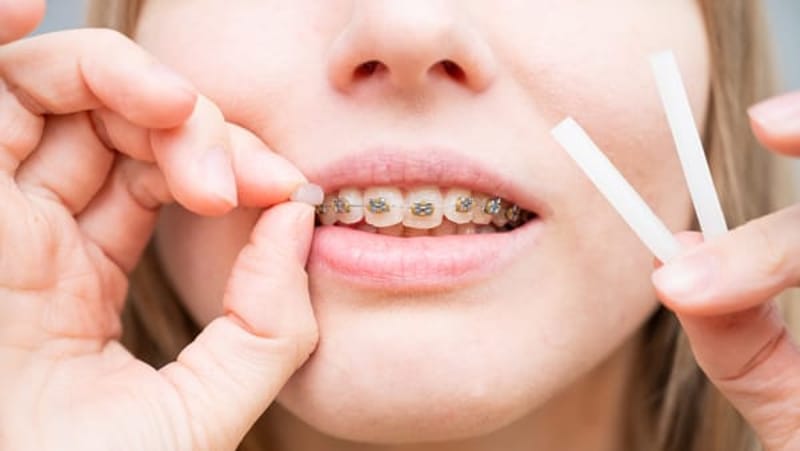Wondering how to use orthodontic wax to make your braces more comfortable? You’re in the right place! We know braces can sometimes be a bit irritating, especially when they rub against the inside of your mouth. But don’t worry, orthodontic wax is a super simple and effective way to tackle this issue.
Read on to see how we’ll cover everything you need to know to use orthodontic wax like a pro, so your orthodontic treatment stays as comfy as possible.
What Is Orthodontic Wax?
Orthodontic wax, often referred to as dental wax, is a soft, pliable material that helps protect the inside of your mouth from the sharp edges of braces and other orthodontic appliances. Made from a combination of natural and synthetic materials, this wax is safe to use in the mouth and easy to apply.
How to Apply Orthodontic Wax
Applying orthodontic wax is straightforward. Follow these simple steps to ensure you do it correctly:
- Clean Your Hands: Always wash your hands thoroughly before handling orthodontic wax.
- Brush Your Teeth: Ensure the area where you will apply the wax is clean and dry.
- Shape the Wax: Take a small piece of wax and roll it into a ball.
- Apply the Wax: Gently press the wax onto the bracket or wire causing irritation.
Step-by-Step Guide to Using Orthodontic Wax
Here’s a detailed step-by-step guide to help you use orthodontic wax effectively:
- Prepare Your Supplies: Gather your orthodontic wax, toothbrush, and mirror.
- Locate the Problem Area: Identify the part of your braces causing discomfort.
- Dry the Area: Use a tissue or cloth to dry the area for better wax adhesion.
- Shape the Wax: Roll a pea-sized amount of wax into a ball with your fingers.
- Apply the Wax: Press the wax firmly onto the braces part until it sticks and covers the irritation source.
- Smooth It Out: Use your finger to smooth the wax, ensuring it’s securely in place.
Benefits of Using Orthodontic Wax
Orthodontic wax offers several benefits for those undergoing orthodontic treatment, making it an popular addition to ortho “go bags” for brace wearers. One of its primary advantages is reducing irritation, as it creates a protective barrier between the braces and the soft tissues of your mouth. This barrier helps to prevent the development of painful sores and ulcers that can result from the constant friction of braces against the cheeks, lips, and gums.
You can also enhance your overall comfort, as it smooths out any rough spots on the braces that might be irritating your mouth. This added comfort can make a notable difference in your daily life, allowing you to focus on your routines without being distracted by pain or irritation.
How to Remove Orthodontic Wax
Removing orthodontic wax is just as easy as applying it:
- Wash Your Hands: Ensure your hands are clean before removal.
- Gently Peel Off the Wax: Use your fingers or a dental tool to gently peel the wax off your braces.
- Brush Your Teeth: Brush your teeth to remove any residue left behind.
When to Use Orthodontic Wax
Newly Placed Braces or Wires
When braces or wires are newly placed, your mouth may take some time to adjust to the new appliances. During this initial period, you may experience heightened sensitivity and irritation as your soft tissues come into contact with the braces for the first time. Orthodontic wax can provide immediate relief by covering the metal parts that cause discomfort, allowing your mouth to adapt more comfortably to the braces.
Broken Brackets or Wires
Broken brackets or wires are common occurrences during orthodontic treatment and can lead to sharp edges or loose components that irritate the inside of your mouth. Using orthodontic wax in these situations helps to cover and smooth out these broken parts until you can visit your orthodontist for repairs. This prevents further irritation and potential injury to the soft tissues in your mouth.
Sharp Edges of Braces or Other Appliances
Braces and other orthodontic appliances can sometimes have sharp edges that cause irritation and discomfort. These edges can rub against the cheeks, lips, and gums, leading to sores and ulcers. Applying orthodontic wax over these sharp areas creates a protective layer that reduces friction and shields your mouth’s soft tissues, making the wearing of braces much more comfortable.
General Irritation from Regular Wear
Even after the initial adjustment period, regular wear of braces can still cause occasional irritation. This could be due to slight movements of the braces, changes in wire positioning, or general sensitivity in certain areas of the mouth. Orthodontic wax is a simple and effective solution for addressing these common discomforts, providing a smooth surface that minimizes irritation and enhances overall comfort throughout the duration of your orthodontic treatment.
Common Issues and Solutions
While using orthodontic wax, you might encounter some common issues. Here’s how to solve them:
- Wax Falls Off: Ensure the area is dry before applying the wax. You might need to use more wax if it keeps falling off.
- Wax Doesn’t Stick: Try warming the wax slightly with your fingers to make it more pliable.
- Discomfort Persists: If the discomfort continues, contact your orthodontist for further advice.

Schedule a Free Consultation
Is your son or daughter still getting used to braces? We can help you understand how to help them adjust – schedule a free consultation! Contact us online or call 440-842-8015
Stay connected with Doctor Andy on Social Media!




